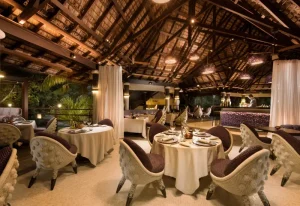Qatar’s instrumental music is one of the most beautiful aspects of their culture and is considered a heritage and a legacy of their older generations. Qatar Traditional Instruments are mainly based on the daily lives of people. Qatari musical instruments and Qatar’s musical folklore are deeply connected with the sea, fishing, poetry, and love.
Qatar’s traditional instruments list consists of several instruments, and each one of them is unique and beautiful, making the folklore music of Qatar rich and lovely. In this article, we will learn more about traditional Qatari instruments.
Table of Contents
ToggleTraditional Qatari Instruments
As an integral part of Qatari culture and music, traditional Qatari instruments have been passed down from old generations to today’s nation of Qatar.
Traditional Qatari instruments are made with a unique focus on the details and design. Qatari musical instruments produce unique sounds that evoke a sense of nostalgia and express poetry-like themes that can be amazing to hear.
Qatar’s traditional instruments also have a great design that features intricate carvings and fascinating details. One of the ways to get to know more about Qatar’s cultural identity is to hear beautiful folklore songs that are played with Qatari musical instruments.
Qatari Musical Instruments History
Qatar’s traditional instruments have evolved as a cultural identity of this country. Since Qatar is geographically located in the Middle East, the nation has taken a lot of influences from other countries.
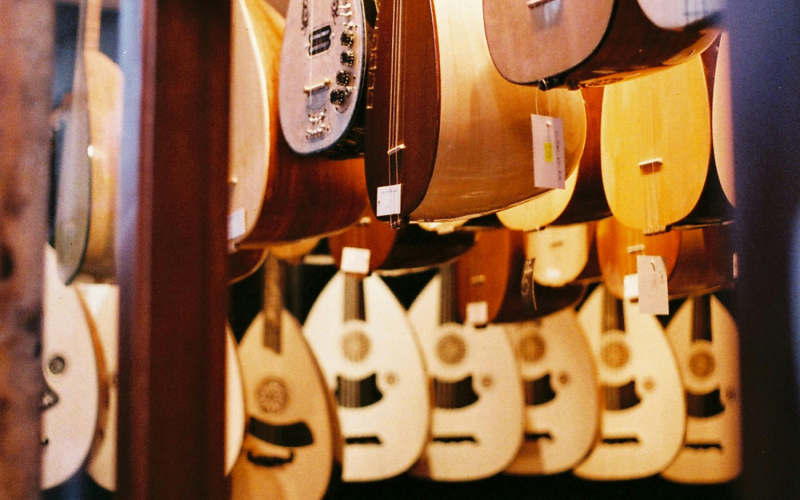
In addition, over the centuries, Qatari music has been shaped by the interactions of the Qatari people with neighboring regions, including Persia, Iraq, and other countries. Moreover, the nomadic Bedouin tribes have also contributed a lot to shaping Qatari musical instruments such as Rababah and Nay, both of which are portable.
The musical expression of the nomadic Qatari tribes merged with the settled populations in Qatar, resulting in a musical identity over time. Traditional Qatari instruments are inspired by Islamic traditions like many other Arabian countries.
Qatar Instrumental Music’s Importance
Instrumental music is an important cultural part of any country. Qatar’s Instrumental Music is a powerful tool that conveys emotions and evokes amazing feelings.
Qatar’s instrumental music expresses diverse themes such as sorrow, joy, love, and human experiences and beautifully portrays the rich and cultural heritage of its past.
Qatar’s traditional instruments list are also considered valuable tools that create these sounds. They carry history and reflect ancient civilizations and old traditions while providing a platform for displaying creativity and artistic expression through music.
Qatar’s instrumental music and Qatar’s traditional instruments are two of the most beautiful aspects of this nation.
Qatar’s Traditional Instrument Names
Qatar’s traditional instrument names are unique and reflect their characteristics and cultural and historical significance while evoking senses with their beautiful sounds. For example, the Oud is recognized as one of the most famous traditional instruments, and its name is derived from the Arabic language, “al-oud” which translates to “the wood” in English.
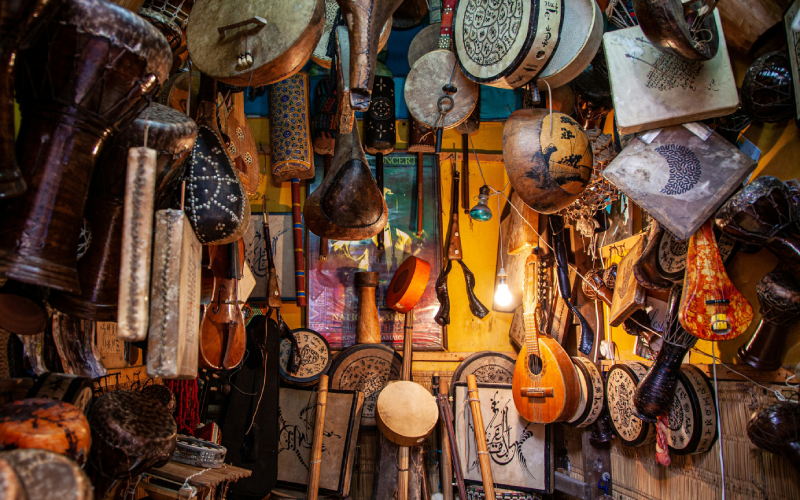
Qatar’s traditional instrument names and their uniqueness give more depth to their art & music and contribute distinctiveness to Qatari music while preserving its historical significance. So, it is essential to learn more about Qatar’s traditional instruments’ names, characters, and historical backgrounds.
Qanun and Violin
Although Qanun and Violin don’t come exactly from Qatar, they have become a huge part of their music and have been in Qatar’s traditional instruments list. Qanun is known for its plucked string and trapezoidal shape and is widely used in the Middle East. Qanun in Arabin means “law” or “rule.”
Violin, on the other hand, also comes from Western origins and has significantly influenced Qatar’s Instrumental Music. This lovely instrument has risen in popularity among Arab communities and Qatari people as a modern and amazing instrument. Violins can easily blend in with different music styles and are great for Qatar’s instrumental music.
Nay
Another traditional instrument in Qatar’s traditional instruments list is the Nay, which is basically a flute-like instrument. Nay is also widely used and played throughout the Arab world and has a long history and great cultural significance.
The Nay is made from hollow reed or bamboo sticks with multiple holes that are designed for fingers. The Nay can be performed for both solo and ensemble pieces and sometimes can accompany vocalists and other instruments as well. The Nay is the symbol of Qatar and is a unique musical instrument.
Oud
The Oud, known as “al-oud,” which translates to “the wood” in English, is another fascinating Qatari musical instrument. This instrument is highly cherished in Qatar and has played a vital role in the country’s musical traditions.
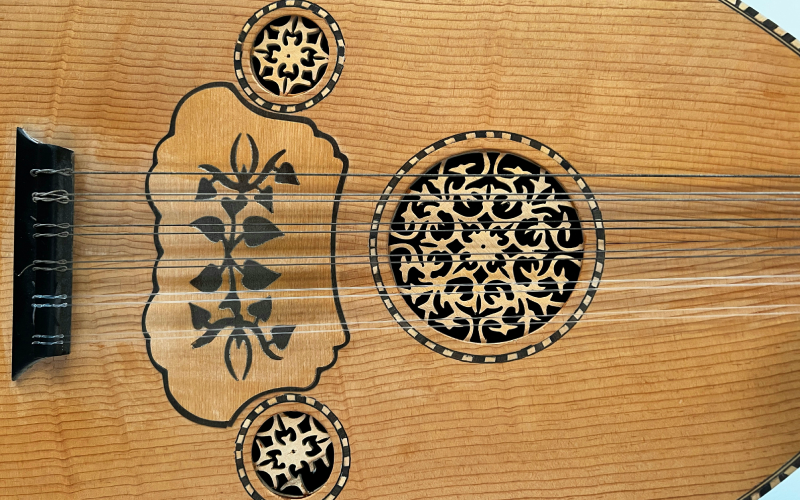
The Oud is a stringed instrument with a pear-shaped body and a short fretless neck. This instrument can include eleven or sometimes thirteen strings. Additionally, the body of the Oud is also made out of wood, and its strings are made of gut or nylon.
In Qatar, the Oud is considered the king of instruments and is widely used in traditional Qatari music.
Tabil & Mirwas
Originating from North Africa and adopted in Arab musical traditions, Tabil is a cylindrical drum with a wooden or metal frame and a drumhead made of animal skin. The Tabil has a striking sound, and the word “Tabil” is derived from the Arabic word “Tabl” meaning “drum.”
Tabil is used in some traditional Qatari musical performances. Compared to Tabil, the Mirwas is another musical instrument that is relatively small and a kind of handheld drum and is usually seen in Arab music. Mirwas is also a unique instrument that adds percussive elements and rhythmic patterns to the music, enhancing the overall sound and driving the tempo.
Rababah
Rababah is another Qatar traditional instrument list that has a fretless neck and a resonating body. Rababah is mainly known due to its desert music characteristics and reflects the nomadic heritage of the country.
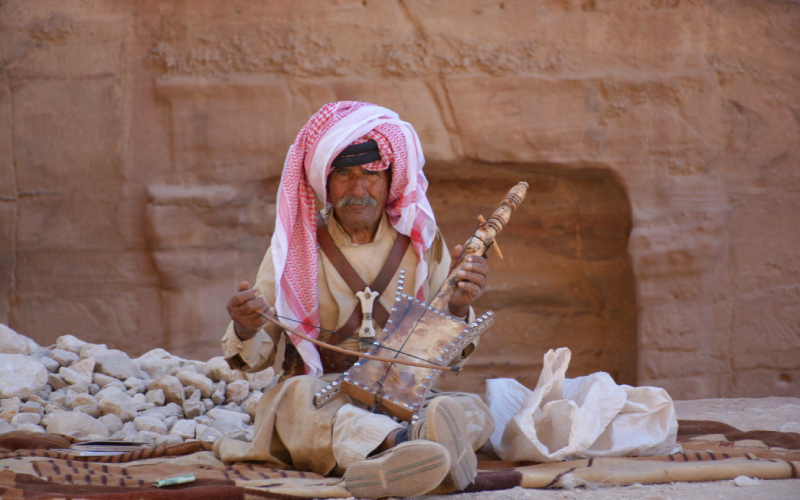
Rababah’s sound expresses melancholic tones, creating a unique and fascinating melody. The Rababah’s sound is ideal for conveying emotions and evoking a sense of nostalgia and melancholy. Rababah playing is intertwined with having great skill and precision. Rababah is also a symbol in Qatar’s Instrumental Music.
Darbaka (Goblet Drum)
The Goblet Drum, called the Darbaka in Arabic Language, is widely used in Arab regions and the Middle East. Darbaka has a goblet-shaped body and is usually made of clay, metal, or wood. Striking the drumhead with the hands and fingertips is the main way of playing Darbaka, which creates pitch and timbre.
Moreover, Darbaka has gained a lot of popularity in recent years among people and in pop, fusion, and other genres of music. Playing Darbaka can add rhythmic depth to musical performances and can evolve and change musical landscapes.
Qatar Instrumental Music Today and Future
Qatar’s instrumental music is a symbol of their nation and a big part of their cultural identity. It is the most unifying element of the Qatari people, which creates social cohesion and a sense of community.
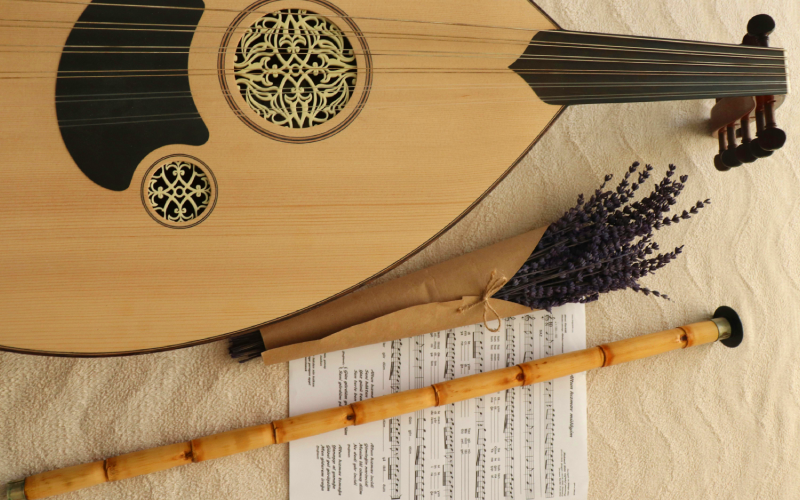
Today, traditional Qatari music is performed during social gatherings, weddings, and cultural events to celebrate their identities while preserving their uniqueness. Qatar’s Instrumental music is also an amazing way to introduce yourself to the rich culture and heritage of the Qatari people.
This genre of music attracts a lot of visitors and tourists from around the world to share their unique moments outside of their political borders.
Final Words
Qatar’s instrumental music comes from a rich history and has left a lasting legacy among the Qatari people worldwide. Its beautiful sounds and themes are very valuable, and Qatar traditional instruments play a vital role in creating these themes and folklore.
If you want to experience some tunes and enjoy Qatar’s Instrumental Music, listen to the sound of their instruments with focus and dive into the stories of the past of Arab people in the nation of Qatar.
Are you planning to travel to Qatar? Please read things to do in Qatar article & Check out our Qatar tours, and Qatar transit tours.





